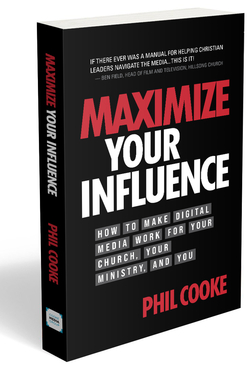
By Phil Cooke, Ph.D.
During the COVID-19 crisis in 2020, I literally monitored hundreds of live stream services. The good news is that during that experience, more and more church leaders finally started taking live streaming seriously. During that time, I made a list of suggestions to help pastors and communication teams. Keep in mind that this was during a time when 100 percent of the congregation was watching online, but chances are,  each of the ideas on this list will help you take your live stream worship to a new level:
each of the ideas on this list will help you take your live stream worship to a new level:
- Make it easy to find! I was amazed at the number of churches who barely mentioned the live stream on their website. With a few church sites, I had to go through five or six clicks to actually find it. Now is the time to make the live stream button BIG and prominently positioned on the home page.
- Give the early viewers something to watch. In my experience, significant numbers of viewers will tune in fifteen to twenty minutes (sometimes more) before it actually starts. Don’t make them stare at a countdown clock graphic or blank screen. Start the live stream early and provide an on-camera host or online pastor to prepare them for the service. It’s a great time for sharing church announcements, a prayer time, or other ways to strengthen the connection.
- When the service starts, consider having the pastor begin with a greeting and/or prayer. Do it just for the online viewers, and it will make them feel more a part of the church family.
- Use graphics! If you have a graphics capability, add scriptures, sermon points, and other notes to help the viewers. Some studies suggest that videos and TV programs that use text graphics help viewers recall significantly more. Fire up your graphics tools and get more helpful information on the screen.
- Get a proven platform for your live stream. Using Facebook live or YouTube live is great, but don’t forget using professional tools like the Church Online Platform on your church website that allows you to insert a countdown clock, chat room, response tools, and more.
- Don’t wait until the end to take an offering. You’d be surprised at how many people will leave the stream early, so if you wait until the end, you’ll lose a significant number of potential givers. Find a good break earlier in the service, or perhaps during the preservice time to address giving.
- Make the live stream available 24/7. I’m surprised at the number of streamed services that end when church service ends. Blank screen. Nothing. I’m unable to replay it. The truth is, you’ll get more viewers outside the normal service times if you make it available on demand.
- This is the most important lesson: It’s time to consider your online audience a legitimate congregation. From this point on, you should treat your online viewers as a campus. That means, if possible, have a pastor for your online viewers and in the chat room, provide them resources, and be more intentional about making them feel welcome. We often forget that there’s always a potential audience watching online. Students away at college, business people who travel, families on vacation.
Regardless of your theological position about what a church service should be, the practical matter is that you’re ignoring a potentially significant number of people when you don’t take your live stream seriously.
I can’t leave the subject of live streaming without saying that as you begin, you may start with only a few viewers. I spoke with a pastor the other day who is dropping the live stream broadcast of his Sunday worship for that very reason. He was frustrated (and probably a little embarrassed) that only eight to ten people were watching, so he felt like it wasn’t worth the trouble.
But let me tell you why that completely misses the point of a live stream:
What if those eight to ten people actually showed up physically and visited the church on a Sunday?
The pastor would be thrilled. He would pull out all the stops to make them feel welcome, enjoy the service, and hopefully come back again.
So why aren’t we as thrilled when we have eight to ten watching online?
We live in a world today where many people want to start the relationship by watching at a distance. Still more can’t physically show up on Sunday due to travel, illness, disability, or something else. Why not make them feel just as welcome as those who actually show up?
Perhaps in a perfect world, everyone would come, be part of the fellowship, worship together, and grow as disciples. But in today’s world, the reality is that won’t happen. But on the positive side, digital technology has given us incredible tools for welcoming far more into the service than you can ever see from the pulpit.
And who knows where it could grow? I met a pastor in the Midwest who takes his live stream very seriously. As a result, although he has seven hundred in his actual service on Sunday, ten thousand are watching online.
During 2020 when churches were shut down because of the Coronavirus, it was a common thing to hear of churches live streaming to three or four times as many people as had ever walked into the actual church.
Don’t worry as much about starting small. Every life you touch with the message of Jesus is worth the effort.
Excerpted from MAXIMIZE YOUR INFLUENCE: How to Make Digital Media Work for Your Church, Your Ministry, and You (© 2020 by Phil Cooke)
ABOUT THE AUTHOR
 Phil Cooke, Ph.D., is Founder & CEO of Cooke Media Group. Cooke has produced TV and film programming or lectured in nearly one hundred countries around the world, and in the process, been shot at, survived two military coups, fallen out of a helicopter, and in Africa, been
Phil Cooke, Ph.D., is Founder & CEO of Cooke Media Group. Cooke has produced TV and film programming or lectured in nearly one hundred countries around the world, and in the process, been shot at, survived two military coups, fallen out of a helicopter, and in Africa, been
threatened with prison. And during that time — through his company Cooke Media Group in Los Angeles, California — he’s helped some of the largest Christian and nonprofit organizations in the world use media to tell their story in a changing, disrupted culture.
Phil was executive producer of Let Hope Rise — the Hillsong Movie released to theaters nationwide, and producer of The Insanity of God, a feature documentary that premiered nationally as a Fathom Event. According to former CNN journalist Paula Zahn, Phil is rare — “the only working producer in Hollywood with a Ph.D. in Theology.” He’s appeared on NBC, MSNBC, CNBC, CNN, Fox News, and his work has been profiled in The New York Times, the Los Angeles Times, and the Wall Street Journal.
He has lectured at universities like Yale, University of California at Berkeley, UCLA, and is currently a visiting professor at Oral Roberts University in Tulsa, Oklahoma. In addition to writing his blog at philcooke.com, he’s contributed to The Huffington Post, Fast Company, Forbes.com, Wired.com, and FoxNews.com. Phil is on advisory boards for The Salvation Army, the Hollywood Prayer Network, and Image Journal. He has been a longtime member of the Academy of Television Arts and Sciences and The Producers Guild of America in Hollywood.


